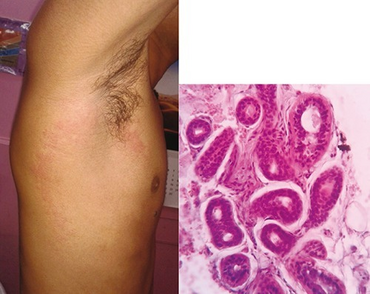Asymmetric periflexural exanthem of childhood
Jump to navigation
Jump to search
| Asymmetric periflexural exanthem of childhood | |
|---|---|
 | |
| a)Unilateral laterothoracic exanthem, starts on the lateral aspect of trunk near the axilla b)presence of perisudoral lymphocytic infiltrates | |
| Specialty | Dermatology |
Asymmetric periflexural exanthem of childhood (APEC) (also known as unilateral laterothoracic exanthem) is a rare, self-limited and spontaneously resolving skin rash of the exanthem type with unknown cause that occurs in children.[1] It occurs primarily in the late winter and early spring, most common in Europe, and affecting girls more often than boys.[2]: 400 [3]
It is probably viral,[4] but no virus has yet been associated with the condition.
See also
References
- ↑ Arun, B; Salim (May–June 2010). "Transient linear eruption: asymmetric periflexural exanthem or blaschkitis". Pediatr Dermatol. 27 (3): 301–302. doi:10.1111/j.1525-1470.2010.01143.x. PMID 20609153.
- ↑ James, William D.; Berger, Timothy G.; et al. (2006). Andrews' Diseases of the Skin: clinical Dermatology. Saunders Elsevier. ISBN 0-7216-2921-0.
- ↑ Rapini, Ronald P.; Bolognia, Jean L.; Jorizzo, Joseph L. (2007). Dermatology: 2-Volume Set. St. Louis: Mosby. pp. 1227–8. ISBN 978-1-4160-2999-1.
- ↑ Zawar VP (2003). "Asymmetric periflexural exanthema: a report in an adult patient". Indian J Dermatol Venereol Leprol. 69 (6): 401–4. PMID 17642951. Archived from the original on 2020-11-26. Retrieved 2021-05-28.
External links
| Classification | |
|---|---|
| External resources |